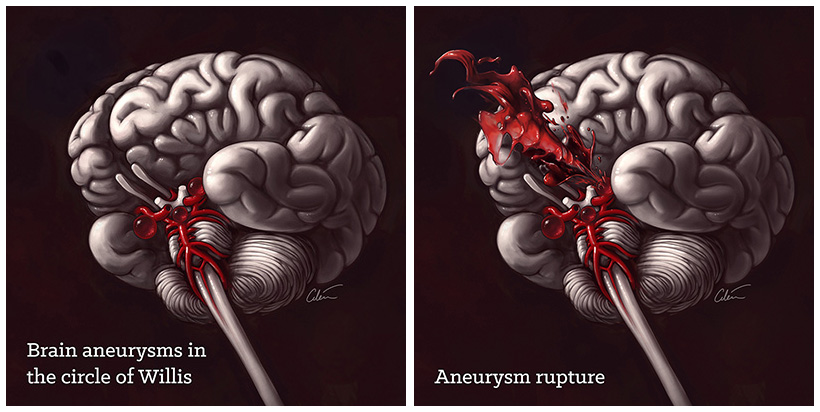Here’s a stat that’s sure to keep you up at night: Currently, anywhere from three to five million people in the U.S. are walking around with brain aneurysms, according to the American Stroke Association.
If you’re thinking “what the heck is a brain aneurysm?” it’s basically a blood vessel in your brain that’s on the verge of an explosion. “Put simply, it’s a weakness that starts to occur in a blood vessel inside the brain or right outside it,” says David Putrino, Ph.D., director of rehabilitation innovation at Mount Sinai Hospital in New York City. “As blood flows through this vessel in the brain, the weak point starts to bulge out like a balloon, and it looks like a berry hanging off a branch.”
Luckily, most aneurysms don’t ever rupture or cause any symptoms. But when they do, things get really serious, really fast. According to the Brain Aneurysm Foundation, about 40 percent of ruptured brain aneurysms lead to death. Others can cause severe brain damage and neurological problems if not treated immediately. “Time is the most important factor in terms of surviving and having less neurological damage from a rupture,” says Putrino.
Here are the brain aneurysm symptoms you need to know about so you can act quickly and keep yourself healthy
1. The Absolute Worst Headaches Of Your Life
“Most ruptured aneurysm survivors report experiencing the worst headache of their lives,” says Putrino. “So if you experience a very sudden and intense headache, where one minute you’re fine and the next minute you’re in extreme pain, that’s often the first sign of a rupture.”
This pain occurs because most aneurysms are in the subarachnoid, or a small, enclosed space just outside the brain, and when they burst, they flood that space with blood, says Putrino. The quick change in pressure is what you feel as a skull-splitting headache coming out of nowhere. “The subarachnoid space has lots of nerve endings, so people start to experience very intense pain,” he says. This headache can be constant or ebb and flow, he says, as each rupture is different. Some may slowly leak while other are torn open all at once.
If you experience a headache unlike anything you’ve felt before, call 911 immediately, he says.
2. Nausea and Vomiting
As the subarachnoid space fills with blood from a ruptured aneurysm, it starts to push the brain down to a point in your skull called the foramen magnum, where your spinal cord and brain stem originate, says Putrino. This pressures the brain stem, an area that controls digestion and breathing can result in you feeling dizzy, nauseated, and vomiting.
Of course, you can experience nausea and vomiting for a whole host of reasons, but if they occur with any of the other brain aneurysm symptoms on this list, you should go to the emergency room, he says.
3. A Ridiculously Stiff Neck
Having a stiff, hard-to-move, and painful neck is a sign of a ruptured aneurysm, says Putrino. “There are a bunch of nerves that control neck movement located in the foramen magnum around the brain stem,” he says. “As a large amount of pressure begins to build there, these are some of the first nerves related to movement to get affected.”
And, yes, this will feel way more intense than “I slept wrong last night.” So if you experience severe neck pain, play it safe and call 911.
4. Facial Tingling and Drooping Features
Similarly, the cranial nerves are also located in the brain stem. And, if there’s a rupture, they can get pushed on, causing facial tingling and paralysis, says Putrino. “Look for drooping features.”
While it’s true that some stroke and brain aneurysm symptoms are similar, both conditions warrant immediate medical treatment, so get to the emergency room ASAP.
5. Blurry or Double Vision
Vision can also be affected when an aneurysm starts bleeding or bursts. As pressure builds on the brain stem, the pons, or the control center for the eyes, is impacted. This can lead to blurry or double vision and sensitivity to light, he says
“If you notice these vision symptoms come on after you get a bad headache, and then maybe you get nausea, that means something is going on neurologically,” he says. Be on the lookout for escalating and combined symptoms.
6. Seizures
If someone experiences a seizure, it could be a sign of a ruptured aneurysm that’s escalating quickly, says Putrino. “A seizure happens when the skull is filling with blood and the brain is getting pushed on from more than one direction, and all the neurons go into distress,” he says. “When a whole bunch of areas in the brain react all at once, this causes a seizure.”
Obviously, if you or anyone else experiences a seizure (and it’s not typical, like with epilepsy) immediately call 911.
7. Hearing A Loud ‘Pop’
Some survivors of aneurysm ruptures report having heard a loud noise before they felt a headache, which is thought to be the sensation of the burst happening. “I’ve heard of this, and it’s possible that people are feeling the big pressure release in a closed space in their skull,” says Putrino. “Though, it wouldn’t make much of an actual noise when it bursts, because it’s soft tissue.”
Still, he notes, this is a valid warning sign that many people share anecdotally, so if you hear a strange pop or snap in your head and then experience pain, that’s good reason to seek medical attention ASAP.



4 Responses
Heeeeeeeeeyyy! May God help us o. Seriously, one mustn’t joke with anything nowadays
God help us.
May God help us. I can’t even place this. Really need to do a medical check up
It is well,someimes not everything is diabolical, one just has to get informed